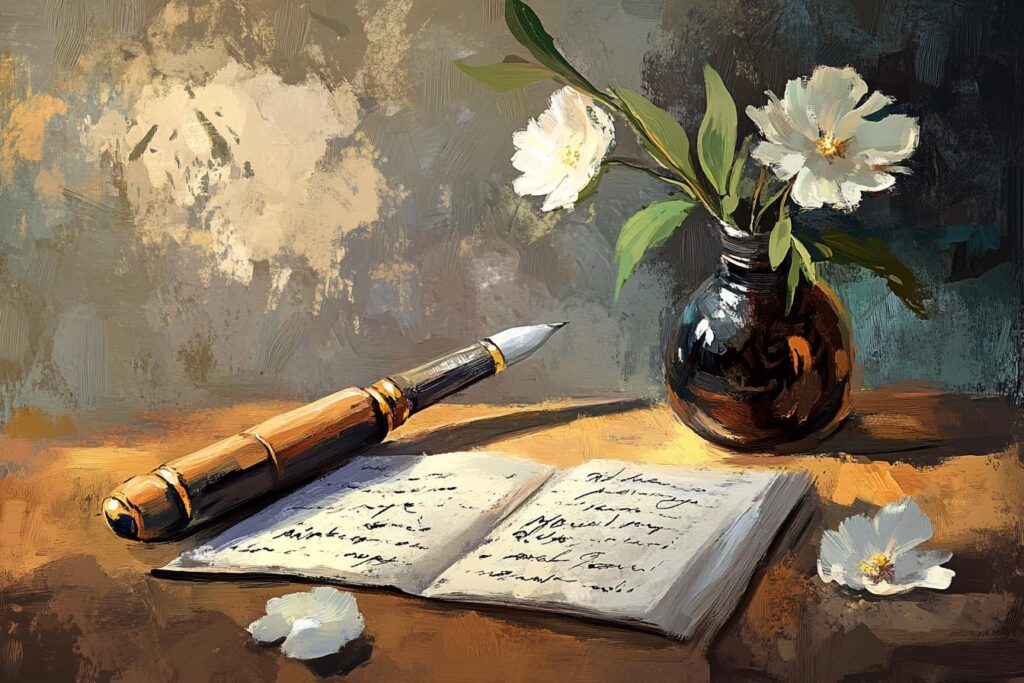Tension in poetry is the art of holding the reader’s attention, keeping them on the edge of their seat, wondering what will happen next. It’s the feeling of anticipation, uncertainty, and even unease that keeps the poem alive and vibrant. You can create tension through a variety of techniques. For instance, introducing a conflict or a mystery that needs resolving can immediately pique the reader’s interest. Consider the classic “The Raven” by Edgar Allan Poe. The poem begins with a speaker mourning his lost love, and then a raven arrives, speaking cryptic words that only deepen the speaker’s grief. This creates a palpable tension that keeps the reader engaged until the very end.
Another way to build tension is through the use of imagery and language. Vivid descriptions, metaphors, and similes can paint a picture of impending doom or a precarious situation. For example, a poem about a storm might use powerful imagery of swirling clouds, crashing waves, and lightning bolts to convey the intensity and danger of the natural world. This heightened imagery creates a sense of suspense and keeps the reader immersed in the poem’s atmosphere. The skillful use of language can transform a simple poem into a gripping narrative, leaving the reader breathless and wanting more.

1. How to Create Tension in a Poem
Tension in poetry, like a taut string on a musical instrument, holds the reader’s attention and creates a sense of anticipation. One way to achieve this is by introducing conflict. This can be between characters, between a character and their environment, or even between conflicting desires within a single character. Think of a character facing a difficult decision, or a character struggling against an overwhelming force. The more we understand the stakes involved, the more we’ll feel the weight of the tension.
Another effective way to build tension is through the use of imagery and language. Instead of simply stating a fact, consider using vivid descriptions that evoke a feeling of unease or uncertainty. For example, instead of writing “The sky was dark,” you could write “The sky was a bruised purple, heavy with the threat of rain.” This kind of evocative language creates a more visceral experience for the reader, pulling them deeper into the world of the poem.
2. Use vivid imagery and sensory details
Imagine a scene: a lone figure standing on a cliff, the wind whipping their hair, the waves crashing below. You can almost feel the spray of salt water on your skin, hear the roar of the ocean, and smell the salty air. This is the power of vivid imagery. When you use strong sensory details in your poem, you pull your reader into the world you’ve created, making them feel as if they are experiencing the scene alongside your characters.
Sensory details go beyond simply describing what you see. You can also evoke sounds, smells, tastes, and textures. For example, instead of simply saying “The night was dark,” you could write “The night was a velvet blanket, thick and silent, smelling of damp earth and pine needles.” This creates a richer experience for the reader, and it can also help to build tension by creating a sense of unease or anticipation.
3. Create conflict between characters or ideas
Conflict is the heart of any good story, and poems are no exception. A clash between characters or opposing ideas creates tension that keeps the reader engaged. You can create conflict by pitting characters against each other, having them struggle with internal dilemmas, or presenting contrasting viewpoints on a subject. The conflict can be overt, like a heated argument, or subtle, like a quiet disagreement about a shared dream. Think of it like building a bridge: the tension comes from the pressure of opposing forces pushing against each other.
When creating conflict, consider the stakes involved. What does each character or idea have to lose? How will the outcome of the conflict affect the world of the poem? The higher the stakes, the more intense the tension will be. For instance, a poem about a character choosing between love and duty will have more impact if the choice carries significant consequences. Remember, the conflict is what drives the poem forward, so make it compelling and impactful.
4. Introduce suspense and uncertainty
Suspense and uncertainty are powerful tools for creating tension in a poem. You can achieve this by withholding information, raising questions, or leaving the reader with a sense of ambiguity. For example, you might describe a mysterious character without revealing their identity, or you might hint at a looming danger without specifying its nature. This creates a feeling of anticipation and keeps the reader engaged, wondering what will happen next.
Another way to introduce suspense is by creating a sense of doubt. This could involve presenting conflicting perspectives, questioning the reliability of the narrator, or leaving the reader to interpret the meaning of events. By challenging the reader’s assumptions, you force them to think critically about the poem and become more invested in its outcome.
5. Employ figurative language and metaphors
Figurative language and metaphors can create a sense of tension by adding layers of meaning and ambiguity to your poem. When you use a metaphor, you compare two seemingly unrelated things, which forces the reader to make connections and think about the implications of the comparison. For example, instead of simply saying “He was angry,” you could write “His anger was a storm brewing inside him.” This metaphor instantly creates a sense of drama and potential for conflict, suggesting that the anger is powerful and uncontrollable.
Similarly, other figures of speech, such as similes, personification, and hyperbole, can also heighten tension. A simile, for instance, can draw attention to a particular aspect of a situation by comparing it to something else. A simile like “Her heart felt as heavy as lead” instantly evokes a feeling of sadness and despair, making the reader wonder what has caused such intense emotions.
6. Build anticipation through rhythm and rhyme
Rhythm and rhyme are powerful tools for building anticipation in a poem. A consistent rhythm can draw the reader into the poem’s flow, creating a sense of momentum. The reader anticipates the next line, waiting to see how the rhythm will develop. Similarly, rhyme can build anticipation by creating a sense of expectation. The reader anticipates the rhyming word, wondering what it will be and how it will connect to the poem’s theme.
In addition to creating expectation, rhythm and rhyme can also create a sense of suspense. If you break the rhythm or rhyme pattern, you can create a jarring effect that draws attention to the change. This can be used to emphasize a particular word or phrase, or to create a sense of unease. A well-placed break in the rhythm or rhyme can leave the reader wanting more, eager to see what happens next.
Conclusions
So, there you have it! By following these tips, you can inject some serious tension into your poems and keep your readers on the edge of their seats. Remember, tension isn’t about making things scary or dramatic; it’s about creating a sense of anticipation and intrigue that draws the reader deeper into the world you’ve created. So, get creative, play with your words, and let the tension build!
Whether you’re writing about love, loss, or the simple beauty of a sunrise, adding tension can elevate your poetry to a whole new level. Go forth and create poems that leave a lasting impression!

